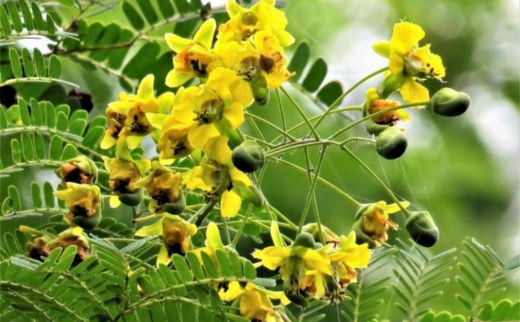Caesalpinia digynaRottl./ Vakeri/ Teri – Ayurvedic Uses, Benefits, Dosage & Therapeutic Actions
Abstract
Caesalpinia digyna Rottl. is a lesser-known yet potent medicinal plant traditionally used in various systems of medicine, including Ayurveda. It is valued for its astringent, anti-inflammatory, and antimicrobial properties, making it useful in managing a variety of ailments. The roots and stems of the plant are especially known for their therapeutic potential. It is usually found in tropical and subtropical regions of India, and it has gained prominence in traditional practices for treating dysentery, diarrhoea, and gynaecological disorders. Its phytochemical composition supports its wide therapeutic use. This article delves into its classical names, morphology, properties, and practical applications.
Introduction
Caesalpinia digyna (Family: Fabaceae), commonly known as Vakeri, is a medicinal plant traditionally used in Ayurveda for managing a variety of health conditions such as wounds, leprosy, skin diseases, fever, diabetes, and gastrointestinal disorders. While the root and stem are well-documented for their therapeutic properties, the medicinal potential of its leaves remains underexplored. The plant is particularly valued for its effects on the digestive and reproductive systems, including its ability to control excessive bleeding and combat infections. Ayurveda highlights its use as a natural remedy to promote overall health and healing. Caesalpinia digyna is drawing renewed interest for modern pharmacological research and home-based treatments.

Scientific Classification
- Kingdom: Plantae
- Subkingdom: Tracheobionta
- Division: Magnoliophyta
- Class: Magnoliopsida
- Order: Fabales
- Family: Fabaceae
- Genus: Caesalpinia
- Species: Caesalpinia digyna Rottl.
Synonyms
- Udakiryaka
- Vakeri
Vernacular Names
- English Name: Teri pods
- Hindi: Vakeri
- Sanskrit: Udakiryaka
- Marathi: Vakeri
- Telugu: Nune-Gacca
- Oria: Gilo, Tari
- Bengali: Kochoi, Amalkuch
Habitat
Caesalpinia digyna is predominantly found in tropical and subtropical regions of India, especially in states like Maharashtra, Madhya Pradesh, and the Western Ghats. It typically grows in open forests, hill slopes, and along forest margins. The plant prefers well-drained, loamy soil and a moderately warm climate for optimum growth.
Morphology
Caesalpinia digyna is a large, woody, perennial climber or scrambling shrub, often found twining over trees and shrubs with the help of curved, hook-like spines on its branches. The stems are slender, brownish, and armed with scattered prickles. Its leaves are compound, bipinnate, alternately arranged, with each pinna bearing several pairs of oblong to lanceolate leaflets that are smooth and glabrous. The plant produces yellow or pale yellow flowers arranged in terminal or axillary racemes, which are mildly fragrant. The fruit is a flat, oblong pod containing 2–4 seeds, which turns brown on maturity. The roots are thick, woody, and brown externally, and are used extensively in traditional medicine for their potent astringent properties.
Ayurvedic Properties
- Taste (Rasa): Bitter (Tikta), Astringent (Kashaya)
- Physical Property (Guna): Light (Laghu), Dry (Ruksha)
- Potency (Veerya): Hot Potency (Usna)
- Post-digestion Effect (Vipaka): Katu (Pungent)
- Effect on Tridosha: Balance Vata, Pitta and Kapha dosha
Therapeutic Properties
- Astringent
- Antimicrobial
- Anti-inflammatory
- Hemostatic (stops bleeding)
- Antidiarrheal
- Antidysenteric
- Tonic
- Antifungal
Systemic Actions
Internal Uses
- Respiratory System: It is effective in the management of cough, asthma, and tuberculosis.
- Urinary System: It is useful in case of diabetes.
Chemical Composition
1. Caesalpinines
- Caesalpinine A
- Caesalpinine C
2. Homoisoflavonoids
- Intricatinol
- Isointricatinol
- E-8-Methoxybonducelline
- Z-8-Methoxybonducelline
- Bonducellin
- Isobonducellin
3. Flavonoids
- Phenolic compounds with antioxidant properties
4. Tannins
5. Phenolic Acids
- Gallic acid
- Ellagic acid
6. Other Bioactive Compounds
- Bergenin
- Friedelin
- Hexacosanoic acid
- β-Sitosterol
- Stigmasterol
Modern Overview
Antioxidant and Antimicrobial Activities in Tuberculosis Management
Several chemical constituents of Caesalpinia digyna Rottl. have demonstrated promising potential in the management of tuberculosis. Compounds such as caesalpinine A, ellagic acid, gallic acid, bergenin, and tannins possess strong antioxidant and antimicrobial properties, which contribute to their therapeutic effects. Caesalpinine A, along with intricatinol and bonducellin, has been shown to interfere with microbial growth, while ellagic and gallic acids offer oxidative stress reduction, enhancing immune response. Bergenin, a polyphenol, has been reported to inhibit bacterial proliferation through the disruption of microbial enzyme systems. Tannins exert antimicrobial activity by precipitating bacterial proteins and forming a protective layer on mucosal tissues. Moreover, the ethanol-water extract of C. digyna roots significantly inhibits Mycobacterium tuberculosis, the bacterium responsible for tuberculosis. This suggests that the plant’s phytochemical synergy may help in controlling TB infections through both direct bacterial inhibition and immune modulation.
Antidiabetic Effect
Bergenin, a key phytochemical found in the roots of Caesalpinia digyna Rottl., has shown promising antidiabetic potential in scientific studies. Various research conducted on streptozotocin-nicotinamide-induced diabetic rats revealed that bergenin significantly reduces fasting blood glucose levels and enhances glucose tolerance. Its mechanism of action is believed to involve the protection and improvement of pancreatic β-cell function, leading to increased insulin secretion. Additionally, bergenin’s strong antioxidant properties help reduce oxidative stress, which is a major contributor to pancreatic damage in diabetes. By supporting insulin activity and protecting pancreatic tissue, bergenin not only helps in glycemic control but also offers potential long-term benefits in diabetes management. As such, it is being considered a potential lead compound for the development of novel antidiabetic drugs.
Antidiarrheal Effect
Caesalpinia digyna Rottl. possesses several bioactive compounds that support its traditional use in managing diarrhoea. Phytosterols such as β-sitosterol and stigmasterol exhibit anti-inflammatory and mucosal-protective properties, which help reduce intestinal irritation and fluid loss. Flavonoids like kaempferol and quercetin contribute through their antioxidant and anti-inflammatory actions, stabilising gut function and reducing excessive peristalsis. Additionally, friedelin and hexacosanoic acid, isolated from the petroleum ether extract of the roots, may support the gut’s structural integrity and reduce hypermotility. Homoisoflavonoids found in the ethyl acetate fraction of methanol extracts are also believed to enhance the plant’s antidiarrheal effects through antimicrobial and anti-inflammatory mechanisms. Together, these constituents work synergistically to alleviate symptoms of diarrhoea by modulating gut inflammation, restoring intestinal balance, and reducing microbial load.
Practical Uses
- For Diarrhoea and Dysentery: A decoction of the root is taken twice daily to reduce loose motions.
- For Excessive Bleeding: Powdered root mixed with honey is taken to control menorrhagia.
- For Oral Health: Powdered dried stem or root is used as a tooth powder to strengthen gums and reduce plaque.
- For Skin Infections: Paste of the root is applied externally over fungal-infected areas.
- For Wound Healing: Root paste is used as a dressing on wounds to promote healing and prevent infection.
Part Used
- Roots
Dosage
- Powder: 3-6 gms
Conclusion
Caesalpinia digyna Rottl. is a valuable medicinal plant rooted in Ayurvedic tradition. Its astringent, antimicrobial, and hemostatic properties make it effective in treating gastrointestinal disorders, bleeding conditions, and skin problems. With its strong phytochemical profile and wide range of systemic actions, this plant deserves more recognition in both traditional and modern herbal medicine systems. When used correctly, it can serve as a powerful natural remedy for various common health issues.



